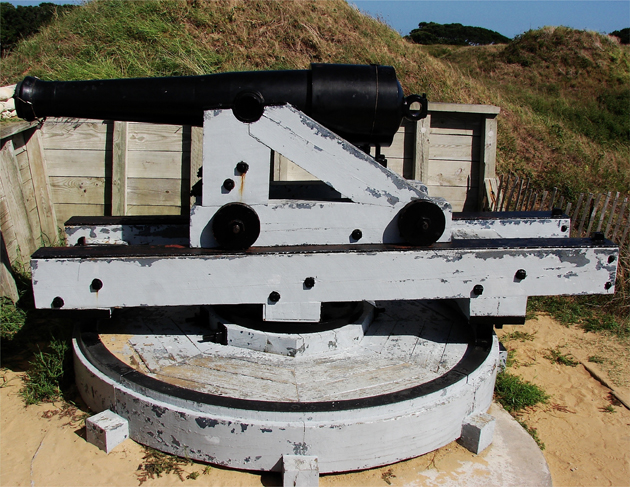Publisher's note: We believe the subject of history makes people (i.e., American people) smarter, so in our quest to educate others, we will provide excerpts from the North Carolina History Project, an online publication of the John Locke Foundation. This twenty-ninth installment, by Jonathan Martin, is provided courtesy of the North Carolina History Project.
Although one of the smallest counties in North Carolina, New Hanover County, located in the southeastern section of the state, serves as an important tourist attraction, trading center, and cultural trademark. Annexed from Craven County in 1729 and named after King George I of the Hanover House, New Hanover's county seat was once called New Carthage. However, after its official establishment, the town became known as Wilmington. The namesake is the Earl of Wilmington, Spencer Compton. The ninth-largest municipality in North Carolina, Wilmington is not the only community within New Hanover; Seabreeze and Castle Hayne are the two other townships within the county.
 Before there was a Wilmington, North Carolina at the narrows of the Cape Fear River there was the Cape Fear, North Carolina's one deep river. This image was made along the shore of Carolina Beach State Park: Above. Kure Beach at Fort Fisher: Below. photos by Stan Deatherage Click the picture to expand to as much as 1000 pixels wide within most expanded images, and then push the arrows embedded in the center edge of the play-box to access the gallery, and slide new images into viewing within the center of the screen.
Before there was a Wilmington, North Carolina at the narrows of the Cape Fear River there was the Cape Fear, North Carolina's one deep river. This image was made along the shore of Carolina Beach State Park: Above. Kure Beach at Fort Fisher: Below. photos by Stan Deatherage Click the picture to expand to as much as 1000 pixels wide within most expanded images, and then push the arrows embedded in the center edge of the play-box to access the gallery, and slide new images into viewing within the center of the screen.

Carolina Beach, Kure Beach, and Wrightsville Beach, located in the town of Wilmington and on the coast of the Atlantic Ocean, have remained top tourist attractions for New Hanover County. Several producers have used the backdrop of the New Hanover coast as a setting for numerous television show series and movies since the 1980s. A major movie business built a large 32-acre studio in Wilmington in 1984, and the increase in tourism and film activity led many media enthusiasts to refer to Wilmington as the "Hollywood of the East."
 Buffeted by the Cape Fear River and the Atlantic Ocean is Fort Fisher, the last Confederate Fort to surrender in the American Civil War: Above. Fort Fisher had an awesome responsibility to endure, with Wilmington being such a huge port and lifeline to the Confederate South. The earthen fort was immense and its defenders brave, and the rifled cannons most accurate for that day: Below. photos by Stan Deatherage Click the picture to expand to as much as 1000 pixels wide within most expanded images, and then push the arrows embedded in the center edge of the play-box to access the gallery, and slide new images into viewing within the center of the screen.
Buffeted by the Cape Fear River and the Atlantic Ocean is Fort Fisher, the last Confederate Fort to surrender in the American Civil War: Above. Fort Fisher had an awesome responsibility to endure, with Wilmington being such a huge port and lifeline to the Confederate South. The earthen fort was immense and its defenders brave, and the rifled cannons most accurate for that day: Below. photos by Stan Deatherage Click the picture to expand to as much as 1000 pixels wide within most expanded images, and then push the arrows embedded in the center edge of the play-box to access the gallery, and slide new images into viewing within the center of the screen.
 The view from the fort of the mighty Cape Fear River near its mouth: Below. photo by Stan Deatherage
The view from the fort of the mighty Cape Fear River near its mouth: Below. photo by Stan Deatherage

Historic sites, cultural attractions, and important events abound in New Hanover County. The Fort Fisher State Historic Site, once a vital Civil War Fort, and the North Carolina Aquarium are located at the most southern edge of New Hanover, at the meeting point of the Atlantic Ocean and the Cape Fear River. Additionally, the U.S.S. North Carolina is located in Wilmington and a commemoration for the ship remains a popular tourist attraction. The Cape Fear Museum, Thalian Hall, Cape Fear Shakespeare, the Wilmington Children's Museum, and the Wrightsville Beach Museum of History are several of New Hanover's cultural establishments. Important festivals and events include the Cape Fear Marlin Tournament at Wrightsville Beach, Old Wilmington by Candlelight, and Countdown on Cape Fear.
 The iconic fixture of Wilmington's waterfront, even thought the ship is across the river on its southern shore, is the "Showboat" - the U.S.S. North Carolina: Above. Even though the classic battleship was not at Pearl Harbor on that fateful day, it still fought in every major naval battle in the Pacific thereafter: Below. photos by Stan Deatherage Click the picture to expand to as much as 1000 pixels wide within most expanded images, and then push the arrows embedded in the center edge of the play-box to access the gallery, and slide new images into viewing within the center of the screen.
The iconic fixture of Wilmington's waterfront, even thought the ship is across the river on its southern shore, is the "Showboat" - the U.S.S. North Carolina: Above. Even though the classic battleship was not at Pearl Harbor on that fateful day, it still fought in every major naval battle in the Pacific thereafter: Below. photos by Stan Deatherage Click the picture to expand to as much as 1000 pixels wide within most expanded images, and then push the arrows embedded in the center edge of the play-box to access the gallery, and slide new images into viewing within the center of the screen.

The North Carolina Azalea Festival, an annual festival held every April, celebrates the beauty of the azaleas in Wilmington. In 1948, the first Azalea Festival was held at Wilmington's Greenfield Lake and Park, and nearly 60,000 people turned out for the event. Today, the festival brings over 300,000 people from across the nation, and Wilmington earns nearly $5 million from the event.
New Hanover has been the birthplace to some vital historic figures for the state of North Carolina. Cornelius Harnett (1723-1781), although born in Chowan County, entered politics when elected Wilmington's town commissioner. A Sons of Liberty chairman, Harnett advocated for the creation of separate North Carolina state, and his name is attributed to Harnett County (1855). William Hooper, another prominent leader in North Carolina's independence from Great Britain, resided in Wilmington during his political tenure.
 The Cape Fear River is solely why Wilmington existed as it did, and to some extent, why it exists as it does today: Above. The Cotton Exchange was the commerce center for North Carolina's largest port. Today small shops and restaurants exist within its sturdy masonry walls: Below. photos by Stan Deatherage Click the picture to expand to as much as 1000 pixels wide within most expanded images, and then push the arrows embedded in the center edge of the play-box to access the gallery, and slide new images into viewing within the center of the screen.
The Cape Fear River is solely why Wilmington existed as it did, and to some extent, why it exists as it does today: Above. The Cotton Exchange was the commerce center for North Carolina's largest port. Today small shops and restaurants exist within its sturdy masonry walls: Below. photos by Stan Deatherage Click the picture to expand to as much as 1000 pixels wide within most expanded images, and then push the arrows embedded in the center edge of the play-box to access the gallery, and slide new images into viewing within the center of the screen.

Thomas F. Price (1860-1919), born in Wilmington, was a priest who helped co-found a foreign missionary society known as the "Maryknoll Fathers." Edwin A. Alderman (1861-1931) was once president of three renowned universities: UNC-Chapel Hill, Tulane, and the University of Virginia; his birthplace was in Wilmington and many historians believe that during his tenure, Alderman was the most vital educator of the South. In addition to these prominent natives, several naval captains and military commanders were born in Wilmington including: William W. Loring, John A. Winslow, and Edwin A. Anderson.
Another famous Wilmingtonian is John Burgwin (1731-1803), who moved to Wilmington from his native land of England in the 1770s. Although he was never a prominent politician, Burgwin built one of North Carolina's finest homes, the Burgwin-Wright House (1771), and his descendants made lasting contributions to the nation's history. John Henry King Burgwin, his grandson, was a hero of the Mexican War; his great grandson,W.H.S. Burgwyn, was a prominent banker; and Henry King Burgwyn, the famed "Boy Colonel," was also his great grandson.
Sources:
Encyclopedia of North Carolina (University of North Carolina Press: Chapel Hill, NC 2006).
"History of Wilmington." Wilmington Chamber of Commerce website. http://www.wilmingtonchamber.org/historyofwilmington.html, (accessed November 9, 2011).
"Cornelius Harnett; Thomas F. Price; Edwin A. Alderman; John Burgwin;." North Carolina Highway Historical Marker Program website. A Division of the North Carolina Department of Cultural Resources. http://www.ncmarkers.com/Results.aspx?k=Search&ct=btn, (accessed November 9, 2011).































